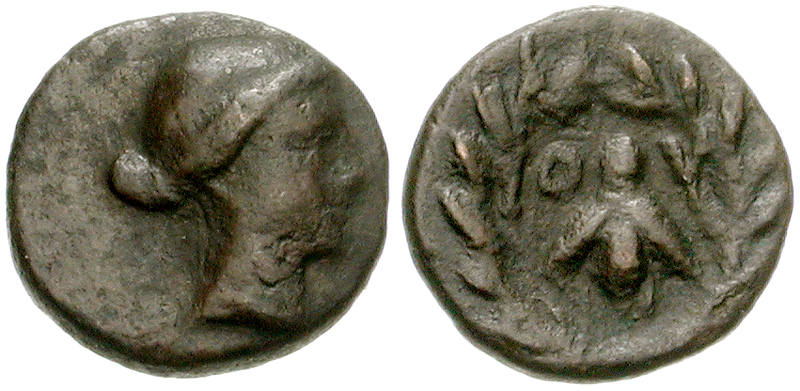S 556 - Iulis, bronze (Ktesylla/bee) (100-30 BCE)
From SILVER
100 BCE - 30 BCE Bronze
Description
| ObverseInscription or printing placed on the obverse.: | Head of Artemis right |
| ReverseInscription or printing placed on the reverse.: | IOY (Greek).Bee within wreath |
Mint and issuing power
| MintIdentifies the place of manufacture or issue of a numismatic object.: | Iulis | Ancient regionAncient region.: | Cyclades | Modern countryModern country: Greece | AuthorityIdentifies the issuing power. The authority can be "pretended" when the name or the portrait of X is on the coin but he/she was not the issuing power. It can also be "uncertain" when there is no mention of X on the coin but he/she was the issuing power according to the historical sources: |
Chronology
| FromIdentifies the initial date in a range assigned in a numismatic context. | 100 BCE | toIdentifies the final date in a range assigned in a numismatic context.. | 30 BCE | PeriodTime period of the numismatic object.: Hellenistic 323-30 BC |
Physical description
| MetalThe physical material (usually metal) from which an object is made.: | Bronze |
Median weightMedian of the weights of numismatic objects (in grams). in grams | 1.40 | DenominationTerm indicating the value of a numismatic object. Examples: tetradrachm, chalkous, denarius.: | StandardStandard.: |
Image

S556 Iulis Ktesylla bee.jpg [1]
References
| Die study referencePublication of the study: | Papageorgiadou-Banis 19971Papageorgiadou-Banis 1997, p. 90-91, n° 112-147 (series XII) | ||
| Coin series referenceReference to coin series study: | |||
| Coin series web referenceCoin series web references: | |||
Obverse dies distribution
| FrequencyFrequency of specimen in distribution. ᵖ | Number of obversesNumber of obverse dies. ᵖ (o) | % (o) | Number of coinsNumber of coins. (n) | % (n) | Die nameName(s) of the die(s). |
| 1 | 11 | 45.83 | 11 | 14.29 | 65, 67, 70, 76, 77, 79, 82, 83, 85, 86, 87 |
| 2 | 4 | 16.67 | 8 | 10.39 | 68, 71, 81, 84 |
| 3 | 3 | 12.5 | 9 | 11.69 | 69, 72, 80 |
| 4 | 1 | 4.17 | 4 | 5.19 | 66 |
| 6 | 1 | 4.17 | 6 | 7.79 | 78 |
| 8 | 3 | 12.5 | 24 | 31.17 | 73, 74, 75 |
| 15 | 1 | 4.17 | 15 | 19.48 | 64 |
| Total | 24 of 24 | 100.01 | 77 of 77 | 100 |
Reverse dies distribution
no distribution is available
Quantification
| Number of obversesNumber of obverse dies. ᵖ (o) | 24 | Number of singletons (o1)The number of singleton coins. ᵖ | 11 |
| Number of reverse diesNumber of reverse dies. (r) | 26 | Number of coinsNumber of coins. (n) | 77 |
| Coins per obverse dieNumber of coins per obverse die. (n/o) | 3.21 | Coins per reverse dieNumber of coins per reverse die. (n/r) | 2.96 |
| Reverse per obverse ratioRatio of obverse dies divided by reverse dies. (r/o) | 1.08 | Percentage of singletons (o1)number of coins (n) divided by the number of singletons (o1) ᵖ | 45.83 % |
| Original number of dies (O) (Carter 1983 formula)The estimation of the number of coins according to Carter 1983 ᵖ | 29.77 | Coins struck if 20,000 as average productivity per dieCoins made if the average productivity for obverses (according to Carter) is 20,000. ᵖ | 595,400 |
| Original number of dies (O) (Esty 2011 formula)The estimation of the number of coins according to the singleton formula in Esty 2011 ᵖ (O) | 34.87 | Survival rate if 20,000 as average productivity per dieSurvival rate if average productivity is 20,000. ᵖ | 0.00013 |
| Coverage (o = % of O) (Esty 1984 formula)Esty 1984 - coverage (% of O) ᵖ (o = % of O) | 85.71% | Die productivity if survival rate 1/2,000Average productivity if survival rate is 1/2,000. ᵖ | 5,172.99 |
| Weight of silver (in kg) if 20,000 coins per die (O = Carter formula)Carter 1983 * Median weight * 20000 (*10 if gold or electrum) ᵖ | n.a. | Die productivity if survival rate 1/5,000Average productivity if survival rate is 1/5,000. ᵖ | 12,932.48 |
Remarks
Most likely one single workstation
References
- ^ Papageorgiadou-Banis, Charikleia (1997), The Coinage of Kea, Meletemata 24, Athens, viii, 107 p., 21 pl.